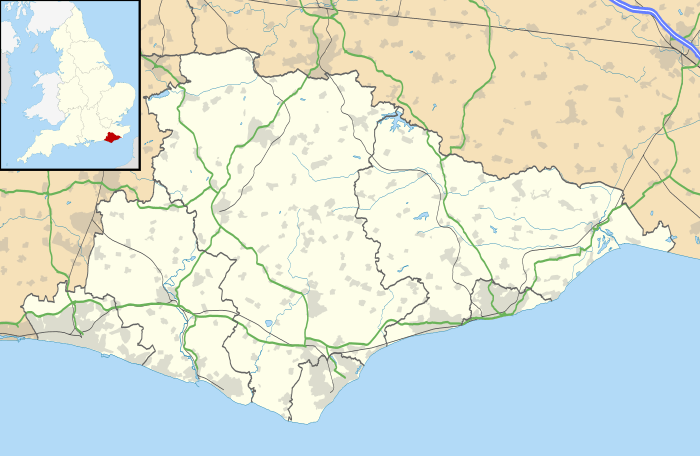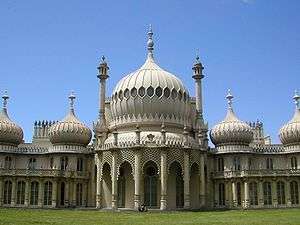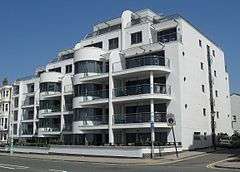Brighton Town Hall (England)
Brighton Town Hall stands on Bartholomew Square in Brighton, East Sussex, England. The town hall contains a number of police cells which were in use until the 1960s, and which now form the Old Police Cells Museum. The town hall is a Grade II listed building.[1]
| Brighton Town Hall | |
|---|---|
_(July_2014)_(1).jpg) Brighton Town Hall | |
| Location | Brighton, East Sussex |
| Coordinates | 50.8208°N 0.1401°W |
| Built | 1832 |
| Architect | Thomas Cooper |
| Architectural style(s) | Greek Revival style |
Listed Building – Grade II | |
| Designated | 20 August 1971 |
| Reference no. | 1379974 |
 Shown in East Sussex | |
History
The site occupied by the town hall was once the location of the Priory of Bartholomew, which was damaged by French raiders in June 1514.[2] The priory disappeared completely as a result of the Chantries Act 1547 and the site was then used as a market place in the 17th century.[3] The current building was commissioned to replace a previous town hall built on the western side of Market Street in 1727.[4]
The foundation stone for the new building was laid by Thomas Read Kemp, a local property developer who had encouraged the initiative, in April 1830.[5] The new building, which was designed by Thomas Cooper in the Greek Revival style and built at a cost of £60,000, was officially opened in 1832.[1] The design included, on each side, a four-storey portico with a Doric order columns below and an Ionic order columns above, with a pediment on top.[1] The local police force, which was formed in 1838, established a police station in the building and police cells in the basement.[6] On 12 and 13 November 1858, the author Charles Dickens gave a reading of A Christmas Carol to a large audience at the town hall[7][8] and, on 16 September 1861, the opera singer Adelina Patti performed there during a concert given by the composer and pianist Wilhelm Kuhe.[9]
In March 2003 the building was entered by activists, notionally protesting at the start of the Iraq War, who caused significant damage to computers and furniture.[10]
The former police cells which had been used for storage since Brighton Police had moved to new facilities in John Street in 1965, were opened up as a museum on 4 May 2005.[11]
Services
Three rooms within the town hall are licensed for wedding ceremonies; these are the Regency Room, The Fitzherbert Room and the Council Chamber.[12] The city's register office is located in the building[13] and the prison cells can be visited as part of the Old Police Cells Museum.[14]
References
- Historic England. "Town hall and attached railings, Bartholomews (1379974)". National Heritage List for England. Retrieved 26 July 2020.
- "Brighton's first map and the French attack of 1514". Brighton Museums. Retrieved 26 July 2020.
- "Brighton & Hove: Historic Character Assessment Report" (PDF). West Sussex Council. p. 38. Retrieved 26 July 2020.
- "The First Town Hall Erected in Market Street 1727". My Brighton and Hove. Retrieved 26 July 2020.
- L. F. Salzman (1940). "A History of the County of Sussex: Volume 7, The Borough of Brighton". British-history.ac.uk. London. pp. 244–263. Retrieved 26 July 2020.
- Nemeth, Robert (11 December 2007). "Brighton Town Hall". Building Opinions. Retrieved 26 July 2020.
- "A Christmas Carol production resurrects 150 year old Charles Dickens script". The Argus. 15 November 2019. Retrieved 26 July 2020.
- Andrews, Malcolm (1997). Charles Dickens and His Performing Selves: Dickens and the Public Readings. Oxford University Press. p. 273. ISBN 978-0199236206.
- "Timeline: 1860s". Brighton History. Retrieved 26 July 2020.
- "Protesters condemn Iraq war". The Argus. 21 March 2003. Retrieved 26 July 2020.
- "Murder scene police museum opens". BBC. 4 May 2005. Retrieved 26 July 2020.
- "Ceremonies in Brighton Town Hall - Brighton & Hove City Council". Brighton-hove.gov.uk. Retrieved 26 July 2020.
- "Register Office". Brighton and Hove City Council. Retrieved 26 July 2020.
- Beaken, Paul. "Brighton Town Hall". The Old Police Cells Museum. Retrieved 26 July 2020.

.jpg)
.jpg)
